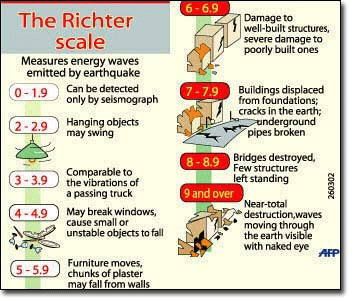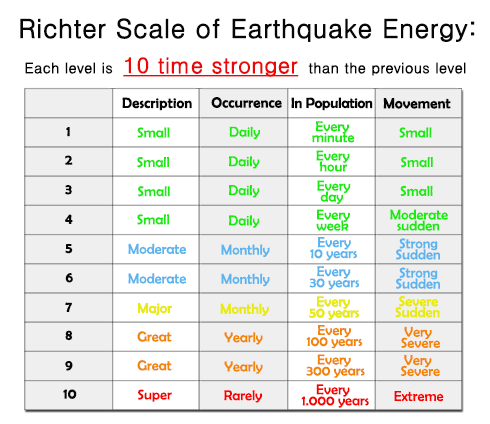What Scale Is Used to Describe the Effects of Earthquakes
The Modified Mercalli scale is designed to describe the effects of an earthquake at a given place on natural features on industrial installations and on human beings. The amount of shaking and damage is known as the earthquakes intensity and it can be measured by the Modified Mercalli Intensity MMI scaleThis scale uses the Roman numerals I - XII to describe the effects of the earthquake in a particular location.
Magnitudes are usually determined from measurements of an earthquakes seismic waves as recorded on a seismogram.

. E Great earthquakes can have a magnitude of 8 or higher. An instrument used to record vibrations in the crust is the seismograph A scale used to classify and describe the effects of earthquakes on terrain construction and local damage conditions is. The Modified Mercalli Intensity MMI scale is commonly used to describe the damage and felt effects of an earthquake at a given location.
The characterization of the impacts of earthquakes generally uses intensity scales describing effects felt in buildings or damage level to these buildings. The Richter scale calculates the strength of an earthquake based on measurements of the amplitude of the largest wave. What is the name of.
There can be multiple intensity measurements. There will actually be a range of intensities within any small area such as a town or county with the. In the US the Modified Mercalli Intensity Scale is commonly used to describe damage caused by earthquakes.
The Richter magnitude scale is a scale of numbers used to tell the size of earthquakes. While the Mercalli scale describes the intensity of an earthquake based on its observed effects the Richter scale describes the earthquakes magnitude by measuring the seismic waves that cause the earthquake. The earthquakes magnitude is determined using the logarithm of the amplitude height of the largest seismic wave calibrated to a scale by a seismograph.
The intensities shown on the map below are the highest likely under the most adverse geologic conditions. World renowned cardiologist explains how with at home trick. The Modified Mercalli scale is designed to describe the effects of an earthquake at a given place on natural features on industrial installations and on human beings.
The idea of a logarithmic earthquake magnitude scale was first developed by Charles Richter in the 1930s for measuring the size of earthquakes occurring in southern California using relatively high-frequency data from nearby seismograph stations. The first intensity scale was developed by Rossi from Italy and Forel from Switzerland in 1880 and was used to describe the effects of the 1918 Puerto Rico earthquake. Click card to see definition.
Earthquake magnitude is a quantitative measure based on physical recordings made on seismometers. A magnitude 5 earthquake. Charles Richter developed the Richter Scale in 1935.
The Richter scale and the Mercalli. Richter scale ML quantitative measure of an earthquake s magnitude size devised in 1935 by American seismologists Charles F. Intensity is a numerical index describing the effects of an earthquake on the surface of the Earth on man and on structures built by man.
The intensity differs from the magnitude which is related to the energy released by an earthquake. There are two ways in which scientists quantify the size of earthquakes. MMI is a qualitative assessment of earthquake effects on structures and people.
A An earthquake of magnitude 3 on the scale is only slightly bigger than a 2. The Richter scale is a way for scientists to describe how much energy was released by an earthquake this is known as the earthquakes magnitude. The magnitude of an earthquake does not tell us how much damage is done by the waves in a particular area.
D The Richter and Moment Magnitude scales are used to describe the magnitude of an earthquake. This magnitude scale was referred to as ML with the L standing for local. SIGNALERT has developed a system of intensity scales which are designed to allow a factual and unambiguous description of different impacts and effects generated by natural phenoma.
Richter and Beno Gutenberg. The Mercalli scale is linear and the Richter scale is logarithmic. The two scales have different applications and measurement techniques.
Seismic magnitude scales are used to describe the overall strength or size of an earthquake. The intensity differs from the magnitude which is related to the energy released by an earthquake. The magnitude of an earthquake is determined by taking the logarithm in base 10 of the greatest movement of the soil recorded during the arrival of a type of seismic wave and.
The Mercalli scale also measures the effects of an earthquake at different locations. Earthquake intensity scales describe the severity of an earthquakes effects on the Earths surface humans and buildings at different locations in the area of the epicenter. Click again to see term.
These are distinguished from seismic intensity scales that categorize the intensity or severity of ground shaking caused by an earthquake at a given location. It uses Roman Numerals from 1 to 8 I to VIII to rate the intensity. You have probably heard of the Richter scale which is still used for small earthquakes but most large earthquakes are now commonly reported using the moment magnitude scale see below.
Tap card to see definition. 4 rows There are two primary scales used to measure earthquakes. Modified Mercalli Intensity Scale.
Two of the most common methods used to measure earthquakes are the Richter scale and the moment magnitude scale. Classify arsenic on the basis of the metabolic. While the Mercalli scale describes the intensity of an earthquake based on its observed effects the Richter scale describes the earthquakes magnitude by measuring the seismic waves that cause the earthquake.
The energy that is released increases by a factor of about 32. The Modified Mercalli Scale measures the amount of shaking at a particular location. The amplitude of an earthquake that scores 30 is about 10 times the amplitude of one that scores 20.



Comments
Post a Comment